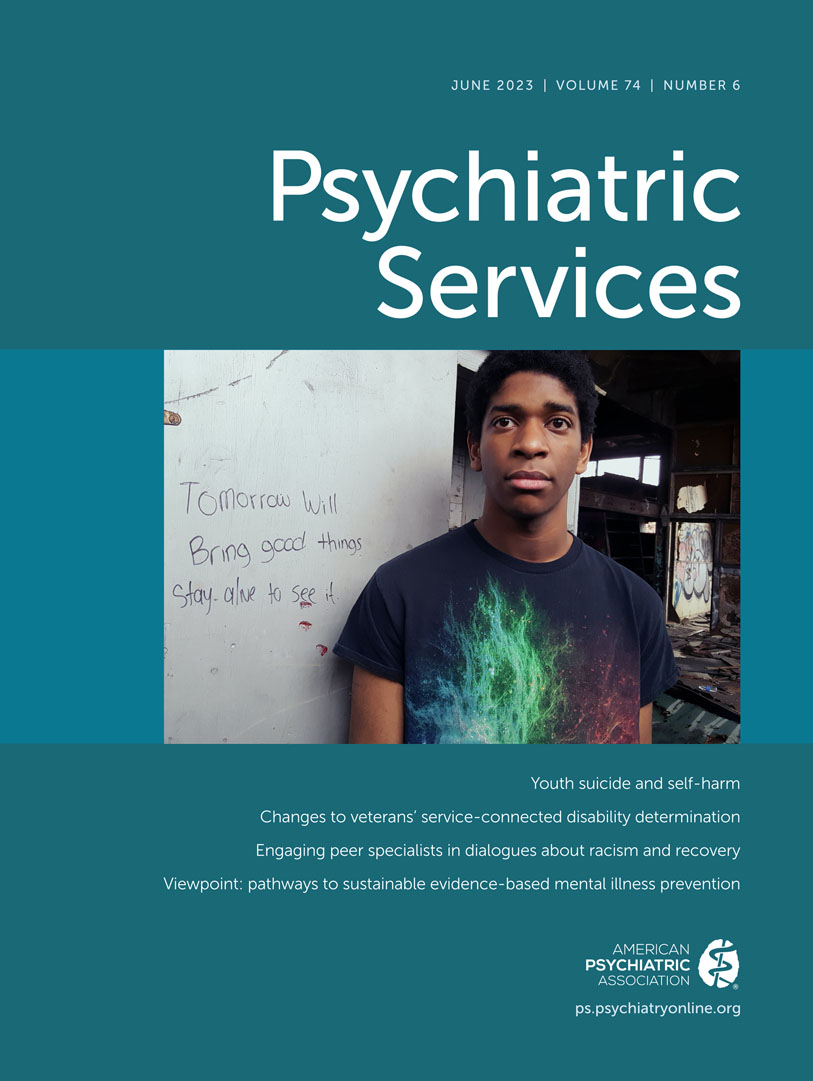The federal Mental Health Parity and Addiction Equity Act (MHPAEA) requires commercial insurance plans that offer benefits for managing mental and substance use disorders to provide them in a “no more restrictive manner” than benefits for medical or surgical services. The policy became effective in 2010, with the final rules issued in 2013 (
1). The MHPAEA applies to state and local government plans and private employer-sponsored plans with >50 employees, as well as plans in the individual market.
Stakeholders lauded federal mental health and substance use disorder parity as a victory in the fight to improve access to treatments for mental and substance use disorders. However, research indicates that the law minimally affects service use and patient spending in commercial plans. Advocates for enforcing the MHPAEA cite insufficient enforcement as being responsible for this marginal impact (
2). Oversight of commercial plans is dictated by the federal McCarran-Ferguson Act (1944) and Employee Retirement Income Security Act (1974). The former allocated regulation and oversight of insurance to the states. The latter transferred regulation and oversight of employer-sponsored, self-insured health plans to the U.S. Department of Labor. As a result, state and federal regulators share minimal enforcement responsibility for the MHPAEA (
3). Additionally, three specific regulations stipulate where the U.S. Department of Health and Human Services (DHHS) enforces the MHPAEA within a state. First, the DHHS oversees state government plans (e.g., plans for state employees); second, the DHHS may assume oversight if it determines that a state is inadequately enforcing the MHPAEA; and third, it may assume oversight if a state determines that its insurance office lacks authority to enforce the law.
Descriptive evidence has documented variation among states in enforcing the MHPAEA (
2,
4). A 2019 report by the Government Accountability Office found that although most states reviewed MHPAEA compliance before initial plan approval, the type and frequency of reviews after consumers were enrolled in the plan varied. Noted differences among states include the frequency and depth of examinations of market conduct and the extent of MHPAEA compliance documentation required for initial plan approval and when insurers make changes to their plans (
4). Differences in powers and enforcement mechanisms afforded to insurance commissioners may drive variability in leverage to obtain compliance from insurers and may lead to disparities in access to treatment across states.
To assess state-level variation in MHPAEA enforcement, it is necessary to establish whether state insurance agencies are given similar powers to enforce laws and regulations broadly and specifically related to the MHPAEA. Differential powers across states, such as the ability to determine timing of insurer examinations or levy fines for any noncompliance, could be sources of enforcement variation. Understanding this variation may provide insight into enforcement barriers and facilitators and may inform approaches to standardize enforcement. The objectives of this study were to categorize insurance commissioners’ powers, responsibilities, and enforcement mechanisms and to explore potential variation across states relevant to MHPAEA enforcement.
Methods
We conducted a comprehensive legal mapping study to delineate powers and responsibilities of state insurance departments relevant to oversight and enforcement in the 46 states enforcing the MHPAEA. The remaining four states determined that their insurance agencies lacked enforcement authority; as a result, the law is enforced by the DHHS in these states. The legal research database Westlaw was searched to identify relevant sections of state laws, state insurance codes, and state regulations as of March 30, 2021.
Initial sections were identified by using the variable domains in Braithwaite et al. (
5) and combined with specific insurance department functions (
3). These domains included policy variables, behavioral variables, and statutory powers. The combination of these domains and the primary functions of insurance agencies (according to the National Association of Insurance Commissioners [NAIC]) formed two overarching dimensions of enforcement actions and administrative actions. Administrative actions included insurance commissioner powers and responsibilities; insurer licensing policies and procedures; and processes for examinations, investigations, and hearings related to insurers’ business practices. On the basis of a 2016 report by the Substance Abuse and Mental Health Services Administration on best practices for state enforcement of the MHPAEA (
6), “relationships with other agencies” was also included.
Subsections with relevant titles were included in the analytic sample. To help ensure that all relevant content was captured, after identifying subsections, we used the Westlaw database search field to search within the state’s overall insurance section for topics of interest addressed in sections with different headings. Relevant sections were abstracted for coding.
Insurance sections were coded deductively and inductively. Initial codebook development was guided by the topics of interest and expanded to incorporate additional powers and responsibilities relevant to MHPAEA enforcement identified inductively during coding. The final codebook was reviewed by members of the study team and included the following categories: commissioner selection, administrative actions, and enforcement actions. Abstracted sections were coded with the final codebook by using ATLAS.ti, version 9. This research was deemed not human subjects research by the Johns Hopkins Bloomberg School of Public Health Institutional Review Board.
Results
Within the 46 states, 450 laws and regulations met our inclusion criteria and were coded with the final codebook. The findings for each of the key domains of interest are shown in
Table 1 and are summarized below.
We found that insurance commissioners were elected in nine states and appointed in 37 states. Commissioners’ primary responsibility was to ensure that insurers can cover the claims for plans they insure. If commissioners believed an insurer could not meet its obligations to policyholders, they could take multiple escalating steps, ranging from closely supervising to liquidating the company.
An important function of state insurance agencies was to license or certify health insurers before approving them to sell plans. Although the NAIC enables insurers to use a uniform process to apply for licenses in multiple states, many states require additional documentation during the application process. All states gave the insurance commissioner authority to suspend or revoke licenses or certificates of authority. Besides suspension or revocation of licensure, commissioners had additional enforcement mechanisms to obtain insurer compliance. In every state, they could issue fines; fine amounts varied, depending on the nature of the violation, typically including a maximum amount for the violation.
We also found that state insurance departments were required to examine insurers applying for a license or certificate of authority in all 46 states. Examinations involved reviewing insurer finances and company business for potential financial risks. The frequency of examinations ranged from at least once every 5 years to “at the discretion of the commissioner.” Commissioners also investigated suspected insurance code violations and presided over hearings. State statutes specified when an investigation or hearing is required and provided the commissioner with discretion as to whether instances beyond those specified warrant investigation or a hearing. As part of their role in hearings, commissioners could issue subpoenas and review internal documents germane to the hearing. Most states also allowed the commissioner to administer oaths and hear testimony.
Finally, many state codes specified a relationship between the insurance agency and the attorney general (AG). The AG was the designated representative of the insurance agency in court and offered legal guidance. In the event of a suspected crime, commissioners could liaise directly with law enforcement or prosecutors’ offices.
Discussion
State and federal governments are prioritizing enforcement of the MHPAEA. This prioritization is evident in reports, analyses, and investigations. Furthermore, the 2021 Consolidated Appropriations Act requires the U.S. Department of Labor to submit biannual compliance reports on employer-sponsored, self-insured plans to Congress. Considering the focus on compliance, understanding whether insurance commissioners have the same leverage to influence insurers is a necessary first step to determine sources of variation in state enforcement of the MHPAEA.
The results of this study suggest that states give insurance commissioners similar powers and mechanisms to enforce insurance policies. Given these similarities, documented differences in enforcement across states are unlikely to be due to insurance statutes (
4,
6). Instead, these differences may be attributable to whether and how commissioners exercise their authority. For example, some states use the licensure process to ask for detailed documentation of MHPAEA compliance, whereas others ask only a single question. Another differentially employed mechanism is the market conduct examination. Whereas some states have broad examinations that may ask about MHPAEA compliance, others employ targeted exams solely focused on assessing compliance.
In their work on responsive regulation, Ayres and Braithwaite (
7) suggest that agencies with a wide range of escalating punitive measures obtain compliance more effectively than agencies with a smaller range. They also advise that regulators consider industry structure and motivations when determining enforcement approaches. They state that mixing punishment and persuasion is most likely to yield compliance. In cases of noncompliance with the MHPAEA, commissioners can respond informally, by working with insurers to obtain compliance, or by escalating to punitive actions such as fines or revocation of licensure.
State laws give insurance commissioners significant discretion over their offices’ activities, unless otherwise specified by the legislature. They also are afforded the power to make regulations related to enforcement of insurance law. Insurance commissioners’ discretion could be a strength, allowing flexibility to work with health insurers. However, this discretion also permits commissioners to choose how and whether to prioritize the MHPAEA in the context of their broader regulatory responsibilities. State legislatures or governors may also require commissioners to produce reports or increase enforcement.
Additional research suggests that potential sources of enforcement variation not captured in the present study may include relationships between health insurers and regulating agencies, collaboration between state government agencies, and the role of state AGs (
8). Although the flexibility afforded to insurance commissioners may facilitate compliance among insurers, it also raises the possibility that commissioners capitulate to insurers, depending on the relationship between the insurance industry and commissioner (
8). Another potential source of enforcement variation is the relationship between insurance agencies and other state-level agencies. For example, health departments may possess clinical expertise to compare mental and substance use disorder services and medical or surgical services that an insurance department needs to assess plan compliance with the MHPAEA (
9). Additionally, differences in state AGs’ decisions to investigate MHPAEA compliance may account for variability among states (
10). The AGs in California, Massachusetts, and New York have investigated or enforced insurer compliance with the MHPAEA (
10–
12).
A final factor relevant to commissioners’ MHPAEA enforcement decisions is the complexity of interpreting the law. The federal government has issued numerous documents clarifying definitions in the MHPAEA and has provided guidance on how to assess compliance. However, state insurance agencies and insurers have ongoing debates about how the MHPAEA applies and how to define compliance. We note that since completion of this research, Missouri has passed a law requiring insurers to comply with the MHPAEA and permitting the commissioner to enforce the law and promulgate rules.
This study had several limitations. The topics included were those that could be categorized, and nuanced variation in policies may have been excluded. Additionally, all statutes were taken from insurance codes or similar sections, and it is possible that statutes relevant to the MHPAEA may be in other sections of state codes and may have been omitted from this sample. Finally, this research did not examine similarities and differences between states that enforce the MHPAEA and those that do not.
Conclusions
Similarities in statutory capacity of insurance commissioners across 46 states enforcing the federal MHPAEA suggest that statutory capacity is not a primary source of variation in enforcement across states.

